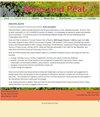Comparison of plant traits of sedges, shrubs and Sphagnum mosses between sites undergoing forest-to-bog restoration and near-natural open blanket bog: a pilot study
IF 1.5
4区 环境科学与生态学
Q4 ENVIRONMENTAL SCIENCES
引用次数: 5
Abstract
In the UK, the majority of peatlands have been damaged by drainage, agriculture, forestry plantations or erosion, compromising the ecosystem services they deliver including carbon sequestration. On the other hand, since the 1990s many projects have carried out a range of interventions to restore peatlands. In forest-to-bog restoration, tree removal and drain blocking lead to immediately visible changes. However, while some key plant species return within years, they may continue to exhibit differences in how they perform and interact with their environment. To investigate this, plant functional traits were measured and compared for Calluna vulgaris, Erica tetralix, Eriophorum angustifolium, Eriophorum vaginatum, Sphagnum capillifolium and Sphagnum papillosum collected in an open blanket bog, a forestry plantation and two forest-to-bog restoration sites in northern Scotland. Significantly lower specific leaf area and chlorophyll content, and higher leaf dry matter content, were found in the open bog site compared with plantation and forest-to-bog sites. This could be related to nutrient enrichment derived from brash and needle decomposition in the latter sites, suggesting a lasting effect of coniferous plantations even after decades of restoration management. Altered plant functional traits may have feedbacks on ecosystem processes such as litter decomposition and peat formation.森林-沼泽恢复和近天然开放覆盖沼泽地莎草、灌木和泥炭藓植物特性的比较:一项初步研究
在英国,大多数泥炭地都受到了排水、农业、林业种植园或侵蚀的破坏,损害了它们提供的生态系统服务,包括碳封存。另一方面,自20世纪90年代以来,许多项目都进行了一系列干预措施,以恢复泥炭地。在森林到沼泽的恢复中,树木的移除和排水沟的堵塞会立即导致明显的变化。然而,尽管一些关键植物物种在几年内回归,但它们在表现和与环境的相互作用方面可能会继续表现出差异。为了研究这一点,测量并比较了在苏格兰北部的一个开放式沼泽、一个林业种植园和两个森林到沼泽恢复点采集的Calluna vulgaris、Erica tetralix、Eriophorum angustifolium、Eriophrum vaginatum、Sphagnum capillifolium和Sphagnumpapillosum的植物功能特征。与人工林和森林到沼泽地相比,开放沼泽地的比叶面积和叶绿素含量显著较低,叶片干物质含量较高。这可能与后一个地点的黄铜和针叶分解产生的营养富集有关,这表明即使经过几十年的恢复管理,针叶林也会产生持久的影响。植物功能性状的改变可能对生态系统过程产生反馈,如枯枝落叶分解和泥炭形成。
本文章由计算机程序翻译,如有差异,请以英文原文为准。
求助全文
约1分钟内获得全文
求助全文
来源期刊

Mires and Peat
ENVIRONMENTAL SCIENCES-
CiteScore
2.30
自引率
16.70%
发文量
0
审稿时长
33 weeks
期刊介绍:
Mires and Peat is a peer-reviewed internet journal focusing specifically on mires, peatlands and peat. As a truly “free-to-users” publication (i.e. NO CHARGES to authors OR readers), it is immediately accessible to readers and potential authors worldwide. It is published jointly by the International Peatland Society (IPS) and the International Mire Conservation Group (IMCG).
Mires and Peat is indexed by Thomson Reuters Web of Science (2017 Impact Factors: 1.326 [two-year] and 1.638 [five-year]), Elsevier Scopus, EBSCO Environment Complete, CABI Abstracts, CSA Proquest (including their Aquatic Science and Fisheries Abstracts ASFA, Ecology, Entomology, Animal Behavior, Aqualine and Pollution databases) and Directory of Open Access Journals (DOAJ). Mires and Peat also participates in the CABI Full Text Repository, and subscribes to the Portico E-journal Preservation Service (LTPA).
Mires and Peat publishes high-quality research papers on all aspects of peatland science, technology and wise use, including:
ecology, hydrology, survey, inventory, classification, functions and values of mires and peatlands;
scientific, economic and human aspects of the management of peatlands for agriculture, forestry, nature conservation, environmental protection, peat extraction, industrial development and other purposes;
biological, physical and chemical characteristics of peat; and
climate change and peatlands.
Short communications and review articles on these and related topics will also be considered; and suggestions for special issues of the Journal based on the proceedings of conferences, seminars, symposia and workshops will be welcomed. The submission of material by authors and from countries whose work would otherwise be inaccessible to the international community is particularly encouraged.
 求助内容:
求助内容: 应助结果提醒方式:
应助结果提醒方式:


